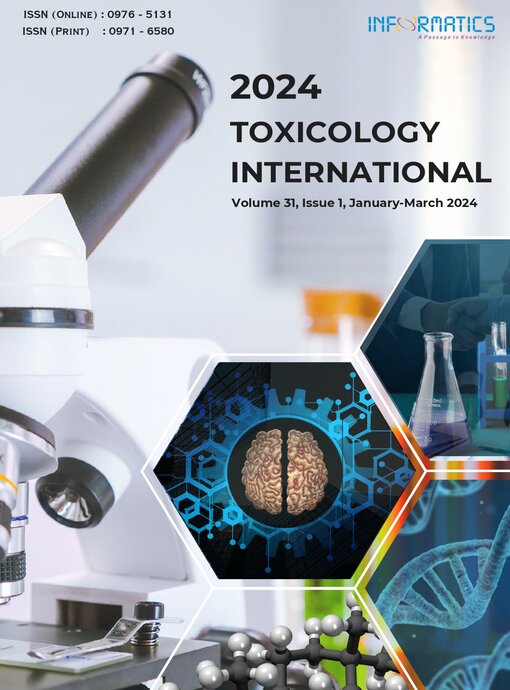Development and Validation of Simple and Stable LCMS Method for the Quantification of Potential Genotoxic Impurities in Ozenoxacin Pure Drug and its Commercial Preparations
DOI:
https://doi.org/10.18311/ti/2024/v31i1/34802Keywords:
Cream Formulation, Ester Impurity, Genotoxic Impurities, LCMS Analysis, Nitroso Impurity, OzenoxacinAbstract
Ozenoxacin is an antibiotic drug prescribed to treat various skin infections caused by various bacteria. Various chemical mechanisms such as stille coupling, Buchwald–Hartwig coupling, cyclization and saponification are involved during the process of synthesis of Ozenoxacin. In the process of synthesis, there is a possibility of the formation of related impurities and among them, some are genotoxic impurities. To date, in literature, there is no method reported for analysing Potential Genotoxic Impurities (PGIs) in Ozenoxacin and hence this study was initiated to develop an LCMS method for quantification of two genotoxic impurities of Ozenoxacin viz., nitroso impurity, ester impurity. The analytes were resolved on Alltima C18 column (150×4.6mm; 5 μm particle size) using 0.01 mM ammonium acetate at pH 4.8 and methanol in 80:20 (v/v) at 0.5 mL/min flow rate and 10 μ sample injection volume. The multiple reaction monitoring of the mass fragments confirms the parent ion at m/z of 364, 393 and 496 for Ozenoxacin, Nitroso and Ester impurity respectively with characteristic product ion at m/z 196. The method has a linearity range of 0.05 μg/mL to 1.0 μg/mL for three analytes with detection limits of 0.015, 0.011 and 0.015 μg/mL for Ester impurity, Ozenoxacin and Nitroso impurity respectively. The method was validated and produces acceptable results and can successfully separate the potential genotoxic impurities in spiked commercial samples. Based on the findings, it was concluded that this method can be practically useful for the identification and quantification of potential genotoxic impurities and may apply to the safe use of Ozenoxacin in clinical treatment.
Downloads
Published
How to Cite
Issue
Section
License
Copyright (c) 2024 P. G. Phaneendra Rao, Battula Sreenivasa Rao, Nagulapati Manjula Bharathi

This work is licensed under a Creative Commons Attribution 4.0 International License.
Accepted 2023-11-17
Published 2024-02-28
References
Kanayama S, Ikeda F, Okamoto K, Nakajima A, Matsumoto T, Ishii R, Amano A, Matsuzaki K, Matsumoto S. In-vitro antimicrobial activity of Ozenoxacin against methicillin-susceptible Staphylococcus aureus, methicillin-resistant S. aureus and Streptococcus pyogenes isolated from clinical cutaneous specimens in Japan. J Infect Chemother. 2016; 22(10):720-3. https://doi.org/10.1016/j.jiac.2016.03.006 PMid: 27091753 DOI: https://doi.org/10.1016/j.jiac.2016.03.006
Kanayama S, Okamoto K, Ikeda F, Ishii R, Matsumoto T, Hayashi N, Gotoh N. Bactericidal activity and postantibiotic effect of Ozenoxacin against Propioni bacterium acnes. J Infect Chemother. 2017; 23(6):374-80. https://doi. org/10.1016/j.jiac.2017.03.004PMid:28389164 DOI: https://doi.org/10.1016/j.jiac.2017.03.004
Gropper S, Albareda N, Chelius K, Kruger D, Mitha I, Vahed Y, Gani M, García-Alonso F. Ozenoxacin in Impetigo Trial Investigators Group. Ozenoxacin 1% cream in the treatment of impetigo: A multicenter, randomized, placeboand retapamulin-controlled clinical trial. Future Microbiol. 2014; 9(9):1013-23. https://doi.org/10.2217/fmb.14.78 PMid:25340832 DOI: https://doi.org/10.2217/fmb.14.78
López Y, Tato M, Espinal P, Garcia-Alonso F, Gargallo- Viola D, Cantón R, Vila J. In-vitro selection of mutants resistant to Ozenoxacin compared with Levofloxacin and Ciprofloxacin in Gram-positive Cocci. J Antimicrob Chemother. 2015; 70(1):57-61. https://doi.org/10.1093/jac/ dku375 PMid:25261416 DOI: https://doi.org/10.1093/jac/dku375
Dembo G, Park SB, Kharasch ED. Central nervous system concentrations of cyclooxygenase-2 inhibitors in humans. The Journal of the American Society of Anesthesiologists. 2005; 102(2):409-15. https://doi.org/10.1097/00000542- 200502000-00026 PMid:15681959 DOI: https://doi.org/10.1097/00000542-200502000-00026
Reddy AV, Jaafar J, Umar K, Majid ZA, Aris AB, Talib J, Madhavi G. Identification, control strategies, and analytical approaches for the determination of potential genotoxic impurities in pharmaceuticals: A comprehensive review. J Sep Sci. 2015; 38(5):764-79. https://doi.org/10.1002/ jssc.201401143 PMid:25556762 DOI: https://doi.org/10.1002/jssc.201401143
Giordani A, Kobel W, Gally HU. Overall impact of the regulatory requirements for genotoxic impurities on the drug development process. Eur J Pharm Sci. 2011; 43(1-2):1- 5. https://doi.org/10.1016/j.ejps.2011.03.004 PMid:21420491 DOI: https://doi.org/10.1016/j.ejps.2011.03.004
Raman NV, Prasad AV, Reddy KR. Strategies for the identification, control and determination of genotoxic impurities in drug substances: A pharmaceutical industry perspective. J Pharm Biomed Anal. 2011; 55(4):662-7. https://doi.org/10.1016/j.jpba.2010.11.039 PMid:21193280 DOI: https://doi.org/10.1016/j.jpba.2010.11.039
Patil P. Development and validation of chromatographic analytical method for Ozenoxacin: Forced degradation studies. Int J Novel Res Dev. 2022; 7(5):1040-6.
Madni JR, Ahmed A, Khan GJ, Khan J. Stability-indicating RP-HPLC method for simultaneous estimation of Ozenoxacin and its degradation products in ointment dosage forms. WJPLS. 2022; 8(8):117-30.
Ramireddy AR, Behara DK. Analytical method validation on simultaneous estimation of Ozenoxacin and Benzoic acid in pharmaceutical formulation. Acta Chromatogr. 2023; 35(3):278-85. https://doi.org/10.1556/1326.2022.01064 DOI: https://doi.org/10.1556/1326.2022.01064
International council for harmonisation of technical requirements for pharmaceuticals for human use, ICH harmonised guideline, analytical procedure development, Q14; 2022.
International council for harmonisation of technical requirements for pharmaceuticals for human use, ICH harmonised guideline, validation of analytical procedures, Q2(R2); 2022.
Varma RB, Rao BS. Gas chromatography-head spaceflame Ionization Sensor based assessment of four residuary solvents in rivaroxaban bulk medication. Res J Pharm Technol. 2022; 15(11):5158-63. https://doi. org/10.52711/0974-360X.2022.00868 DOI: https://doi.org/10.52711/0974-360X.2022.00868
Varma RBH, Rao BS. Gas Chromatography-head spacemass spectrometry sensor-based quality control of Dobutamine Hydrochloride bulk material for a mutagenic impurity, 2-bromopropane. Res J Chem Environ. 2023; 27(2), 54-61. https://doi.org/10.25303/2702rjce054061 DOI: https://doi.org/10.25303/2702rjce054061
Bhupatiraju RV, Rao BS, Rao KMVN, Reddy MV. A novel Rivaroxaban degradation impurity detection by RP-HPLC extraction by preparative chromatography, and characterization by LC-MS, NMR and FT-IR: Analysis of novel impurity in batch samples and tablets of Rivaroxaban. Rasayan J Chem. 2022; 15(4),2373-81. https://doi.org/10.31788/RJC.2022.1547008 DOI: https://doi.org/10.31788/RJC.2022.1547008
Bhupatiraju RV, Battula SR, Kapavarapu MVNR, Mandapati VR. Assessment of gas chromatography methodology approach for the trace evaluation of carcinogenic impurity, methyl chloride, in trimetazidine dihydrochloride. Ann Pharm Fr. 2023; 81:64-73. https://doi.org/10.1016/j. pharma.2022.06.012 PMid:35803334 DOI: https://doi.org/10.1016/j.pharma.2022.06.012
 P. G. Phaneendra Rao
P. G. Phaneendra Rao







